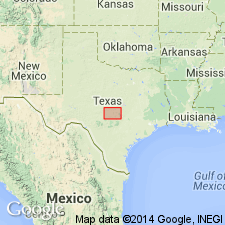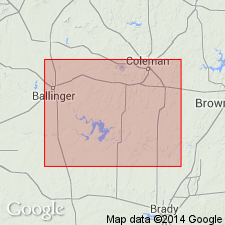
- Usage in publication:
-
- Indian Creek bed
- Modifications:
-
- Original reference
- Dominant lithology:
-
- Clay
- Shale
- Coal
- AAPG geologic province:
-
- Bend arch
Summary:
Pg. 421, 423. Indian Creek bed in Albany division. Clay, more or less sandy throughout, at many places slightly shaly, and at some places carbonaceous; of bluish, purplish, and yellowish colors. Thickness 75 to 100 or more feet. Member of Albany division [Albany is uppermost of 5 Carboniferous divisions of Cummins, 1891]. Overlies Hordes Creek bed and underlies Bed No. 5 (25 to 60 feet of limestone with some marly clay). Age is possibly Permian.
[Named from Indian Creek, Coleman Co., Colorado River region, central TX.]
[See also GNC remark (Wilmarth, 1938, US geologic names lexicon, USGS Bull. 896) under Pennsylvanian Indian Creek.]
Source: Publication; US geologic names lexicon (USGS Bull. 896, p. 1009).

- Usage in publication:
-
- Indian Creek shale
- Modifications:
-
- Revised
- AAPG geologic province:
-
- Bend arch
Summary:
Pg. 192, 193, and charts. Indian Creek shale member is included in Admiral formation (basal formation of Wichita group). Overlies Hordes Creek limestone lentil and underlies "bed No. 5" of Drake. [Age is Permian.]
Source: US geologic names lexicon (USGS Bull. 896, p. 1009).

- Usage in publication:
-
- Indian Creek shale member†
- Modifications:
-
- Abandoned
- AAPG geologic province:
-
- Bend arch
Summary:
Sheet 2; R.C. Moore IN A.K. Miller and Walter Youngquist, 1947, Kansas Univ. Paleo. Contrib., no. 2, Mollusca, art. 1, p. 1, 2. †Indian Creek shale member of Admiral formation renamed Wildcat Creek shale. Name Indian Creek preoccupied by Indian Creek of Pennsylvanian age.
Source: US geologic names lexicon (USGS Bull. 1200, p. 1863).
For more information, please contact Nancy Stamm, Geologic Names Committee Secretary.
Asterisk (*) indicates published by U.S. Geological Survey authors.
"No current usage" (†) implies that a name has been abandoned or has fallen into disuse. Former usage and, if known, replacement name given in parentheses ( ).
Slash (/) indicates name conflicts with nomenclatural guidelines (CSN, 1933; ACSN, 1961, 1970; NACSN, 1983, 2005, 2021). May be explained within brackets ([ ]).

